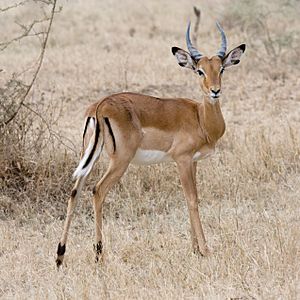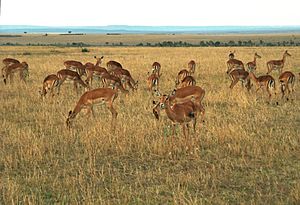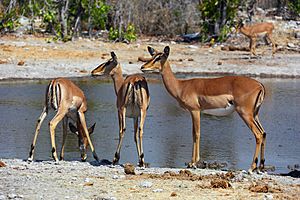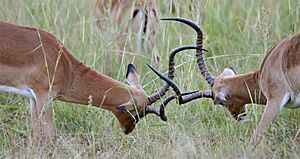Impala facts for kids
Quick facts for kids Impala |
|
|---|---|
 |
|
| A male impala in the Serengeti | |
| Scientific classification | |
| Kingdom: | |
| Phylum: | |
| Class: | |
| Order: | |
| Family: | |
| Subfamily: |
Aepycerotinae
Gray, 1872
|
| Genus: |
Aepyceros
Sundevall, 1847
|
| Species: |
A. melampus
|
| Binomial name | |
| Aepyceros melampus (Lichtenstein, 1812)
|
|
The impala is a medium-sized antelope that lives in eastern and southern Africa. It is the only member of its kind in the genus Aepyceros. A German scientist named Hinrich Lichtenstein first described the impala in 1812.
There are two types of impalas: the common impala and the black-faced impala. The black-faced impala is usually bigger and darker. Impalas stand about 70 to 92 centimeters (28 to 36 inches) tall at the shoulder. They weigh between 40 and 76 kilograms (88 to 168 pounds). Impalas have a shiny, reddish-brown coat. Male impalas have long, thin horns shaped like a lyre, which can be 45 to 92 centimeters (18 to 36 inches) long.
What Impalas Look Like
Impalas are medium-sized and slender antelopes. They are similar in shape to animals like the kob or Grant's gazelle. An impala's body, from head to tail, is about 130 centimeters (51 inches) long.
Male impalas are usually taller than females. Males stand about 75 to 92 centimeters (30 to 36 inches) at the shoulder. Females are a bit shorter, at 70 to 85 centimeters (28 to 33 inches) tall. Males are also heavier, weighing from 53 to 76 kilograms (117 to 168 pounds). Females weigh less, from 40 to 53 kilograms (88 to 117 pounds).
Female impalas do not have horns and are smaller than males. Male impalas grow slender, lyre-shaped horns that are 45 to 92 centimeters (18 to 36 inches) long. These horns have strong ridges and spread outwards. They are hollow at the base. The curved shape of their horns helps males lock them together during fights. This also protects their heads from harm.
An impala's shiny coat has two colors. Their back is reddish-brown, and their sides are tan. These colors stand out against their white belly. They have white rings around their eyes and a light chin and snout. Their ears are about 17 centimeters (7 inches) long and have black tips. Black stripes run from their rear down to their upper back legs. Their bushy white tail is about 30 centimeters (12 inches) long and has a solid black stripe down the middle.
Impala Behavior
Impalas are mostly active during the day. However, they tend to rest during the hottest parts of midday. They will feed and rest at night when it is cooler.
Impalas are an important food source for many meat-eating animals. These predators include cheetahs, leopards, and lions. Impalas have two special ways of jumping to escape danger. They can leap up to 3 meters (10 feet) high, jumping over plants or even other impalas. They can cover distances of up to 10 meters (33 feet) in a single jump.
The other type of leap involves a series of jumps. The impala lands on its front legs, kicks its back legs in the air, lands on all four legs, and then bounces again. They jump in different directions to confuse predators. Sometimes, an impala might also hide in plants to avoid being seen. Their loudest sound is a loud roar. This roar starts with one to three loud snorts with their mouth closed. Then, they make two to ten deep grunts with their mouth open, chin up, and tail raised. You can hear a typical impala roar from up to 2 kilometers (1.2 miles) away.
What Impalas Eat

Impalas eat both leaves from bushes (browsing) and grasses (grazing). What they eat more of depends on what food is available. Impalas like to stay close to water sources. If water is hard to find, they will eat juicy plants that hold a lot of water. Impalas prefer to eat soft and nutritious grasses.
One study showed that impalas spend the most time looking for food during the late dry season. This can be up to 75.5% of their day. This time decreases during the rainy season. It is lowest in the early dry season, at about 57.8% of their day.
Images for kids
-
An impala stotting
-
Impala have a symbiotic relationship with oxpeckers.
-
Two males fighting for dominance
-
Impalas of Kruger National Park, RSA
See also
 In Spanish: Impala para niños
In Spanish: Impala para niños











